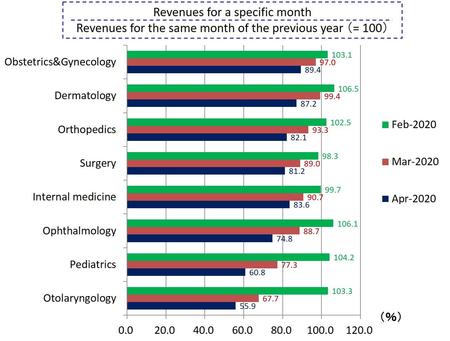Column Finance and the Social Security System 2020.07.28
【Aging, safety net and fiscal crisis in Japan】No.248: People are refraining from going to hospitals and clinics for fear of COVID-19
In this column series, Yukihiro Matsuyama, Research Director at CIGS introduces the latest information about aging, safety net and fiscal crisis in Japan with data of international comparison.
People are refraining from going to hospitals and clinics because of the emergence of clusters of people infected with coronavirus (COVID-19). According to the Ministry of Health, Labor and Welfare, the revenue of hospitals and clinics increased to 103.3% and 102.1%, respectively, in February 2020; the figure for the same month in the previous year was 100% (Figure 1). However, in April, hospital revenues fell to 91.7%, constituting an 8.3% decrease compared to the same month in the previous year. The decrease rate in clinics was even higher at 20.3%.
Figure 2 shows the change of revenues in clinics by specialized departments. In April 2020, the decrease rate of otolaryngology, pediatrics, and ophthalmology was 44.1%, 39.2%, and 25.2%, respectively. From the viewpoint of infectious disease prevention, the reduction in the vaccination rate of children has been pointed out as a major problem. For example, the number of first-time recipients of the Japanese encephalitis vaccine (for 3-year-old children) has decreased by 35%. The number of second vaccinations of the mixed measles/rubella vaccine, which is required a year before children enter elementary school, has decreased by 47%. These figures reveal that the government must establish a system that allows parents to feel safe taking their children to a medical institution for vaccinations.
Figure 1 Change of revenues in hospitals and clinics

*Please click the table image to find the original size image.
Source: Ministry of Health, Labor, and Welfare
Figure 2 Change of revenues in clinics by department

*Please click the table image to find the original size image.
Source: Ministry of Health, Labor, and Welfare
